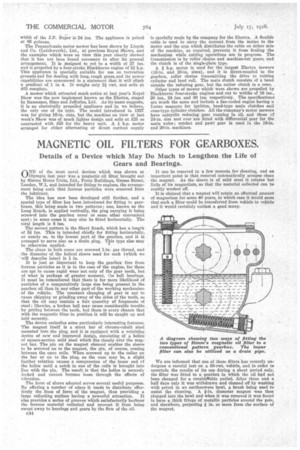MAGNETIC OIL FILTERS FOR GEARBOXES.
Page 66

If you've noticed an error in this article please click here to report it so we can fix it.
Details of a Device which May Do Much to Lengthen the Life of Gears and Bearings.
riNE of the most novel devices which was shown at NJ Olympia last year was a magnetic oil filter brought out by Simms Motor Units, Ltd., Percy Buildings, Gresse Street, London, W.1, and intended for fitting to engines, the arrangement being such that ferrous particles were removed from the lubricant.
The idea has now been developed still further, and a special type of filter has been introduced for fitting to gearboxes, this being made in two patterns; one, known as the Long Reach, is applied vertically, the plug carrying it being screwed into the gearbox cover or some other convenient spot ; in some cases it may also be fitted horizontally. The total length is 8 ins.
The second pattern is the Short Reach, whieh has a length of 51 ins. This is intended chiefly for fitting horizontally, or nearly so, to the lowest part of the gear'oox, and it is
arranged to serve also as a drain plug. This type also may
be otherwise applied.
The plugs in both cases are screwed 1-in, gas thread, and the diameter of the helical sleeve used for each (which we ' will describe later) is 1 in.
It is just as important to keep the gearbox free from ferrous particles as it is in the case of the engine, for these are apt to cause rapid wear not only of the gear teeth, but of what is perhaps of greater moment, i!te ball bearings. It must be remembered that there is far more likelihood of particles of a comparatively large size being present in the gearbox Oil than in any other part of the working mechanism of the vehicle. The constant changing of gear is apt to cause chipping or grinding away of the sides of the teeth, so that the oil may Contain a fair quantity of fragments of steel; likewise, a broken ball may cause considerable trouble by getting between the teeth, but there is every chance that with the magnetic filter in position it will be caught up and held securely.
The device embodies some particularly interesting features. The magnet itself is a stout bar of chrome-cobalt steel mounted into the plug, and it is equipped with a retaining device of new and improved design, consisting of a helice of square-section mild steel which fits closely over the magnet bar. The pin on the magnet element enables the sleeve to be screwed on to the magnet, the pin, of course, coming between the open coils. When screwed up to the collar on the bar or on to the plug, as the ease may be, a slight further rotation causes a compression of the inner end ef the helice until a notch in one of the coils is brought into line with the pin. The result is that the helice is securely locked and cannot become loose through the effects of vibration.
The form of sleeve adopted serves several useful purposes. By offering a number of edges it tends to distribute effectively the lines of force of the magnet, thus providing a large collecting surface having a powerful attraction. It also provides a series of grooves which satisfactorily harbour the ferrous material collected and prevent it from being swept away to bearings and gears by the flow of the oil.
c44 It can be removed in a few seconds for cleaning, and an important point is that removal automatically scrapes clean the magnet. As the sleeve is of mild steel it retains but little of its magnetism, so that the material collected can be readily washed off.
It is claimed that a magnet will retain an effectual amount of magnetism for some 40 years, in which case it would seem that such a filter could be transferred from vehicle to vehicle and it would certainly outlast a good many.
We are informed that one of these filters has recently undergone a careful test on a 30-cwt. vehicle, and in order to ascertain the results of its use during a short period only, the filter was fitted to a gearbox in which the oil had not been changed for a considdtable period. After three and a half days only it was withdrawn and cleaned off by washing with petrol in an earthenware bowl, a brush being used to assist the cleaning, A fin, diameter magnet was then Plunged into the bowl and when it was removed it WAR found to have a thick fringe of metallic particles around the pole, and elsewhere, projecting I in. or more from the surface of the magnet,












































































































